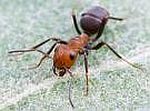Argentine Ants
Linepithema humile
 |
|
Workers are all the same size, small, 1/8-inch long -Uniformly dull brown -Petiole with 1 erect node -Thorax uneven in shape when viewed from side -Musty odor emitted when crushed
Habits
Feed on sweets, fresh fruit, and buds of some plants -Tend honeydew-producing species -Forage for sweets and oils in homes -Travel rapidly in distinctive trails along sidewalks, up sides of buildings, along branches of trees and shrubs, along baseboards, and under edges of carpets -Colonies may split in spring and summer when queen and workers move to new site; not antagonistic toward each other.
Habitat
Outdoors in soil, under wood, slabs, debris, mulch, or in branches and cavities of trees and shrubs -Shallow, 1- to 2-inch deep mounds in open, often disturbed habitats, either moist or dry -Millions of ants per colony with multiple queens and many subcolonies
Threats
Argentine ants do not pose a health threat, but they can contaminate food.
Prevention:
Eliminate standing water as they are attracted to moisture. Keep tree branches and other plants cut back from the house. Sometimes pests use these branches to get into your home. Make sure that there are no cracks or little openings around the bottom of your house. Sometimes pests use these to get into your home. Make sure that firewood and building materials are not stored next to your home. Pests like to build nests in stacks of wood.


